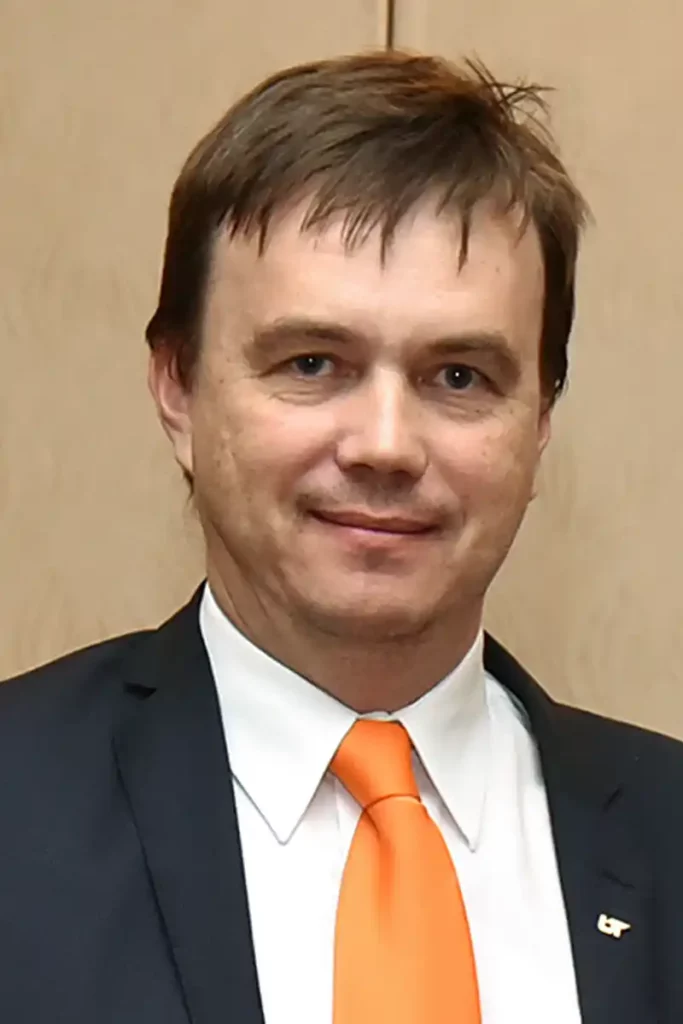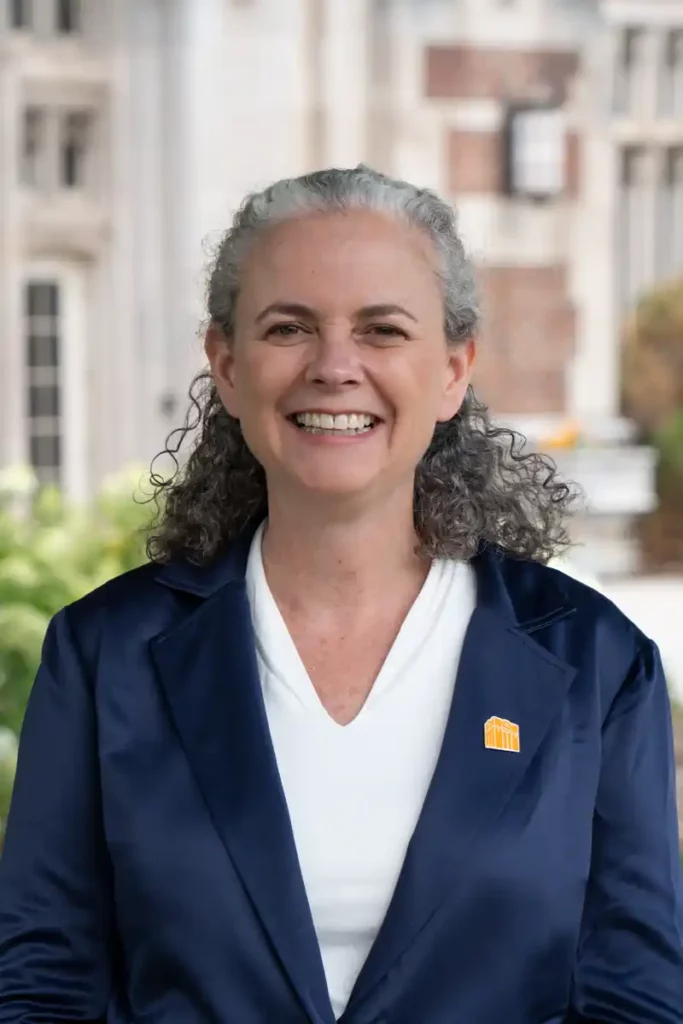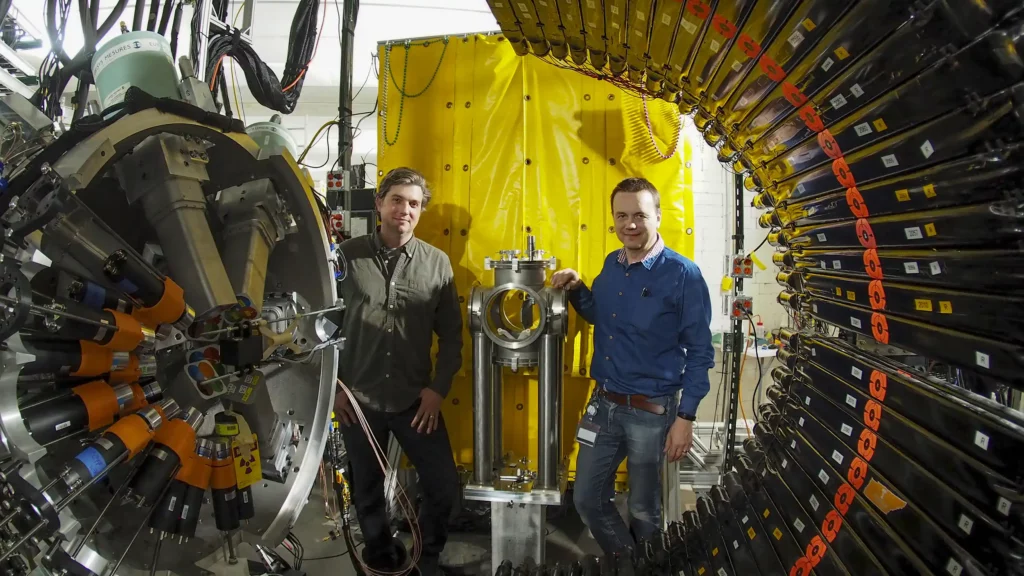Where Instability is a Good Thing


FRIB just published the first paper from its first experiment. UT’s physicists built the tools that made it possible.
The email came with a simple subject line: “Now with ribbon.”
Professor Robert Grzywacz was at Michigan State University sending photos as dignitaries cut a giant green ribbon to open the Facility for Rare Isotope Beams (FRIB). For him and his colleagues it was more than christening a powerful research facility. It was a new chapter in a story of scientific creativity, and community, and turning drawbacks into opportunities.
Things Fall Apart
Grzywacz, like Professor Kate Jones and Assistant Professor Miguel Madurga, dwells in the land of low-energy nuclear physics. They’re interested in how a nucleus is structured, how stable it is, and the way its components interact. Rare isotopes are an ideal vehicle to find out.
FRIB creates these exotic nuclei by stripping electrons from stable atoms and guiding the resulting ions into a linear accelerator where they travel faster than half the speed of light. When the beam hits a target, nuclei lose protons or neutrons, creating unstable, short-lived rare isotopes. FRIB can stop and re-accelerate the beam, filtering out isotopes so that researchers get the ones they want.
Studying isotopes as they fall apart gives scientists a window into a nucleus’s innermost mysteries, knowledge that moves science forward and also meets practical needs.
“There are applications from medical imaging and therapy to energy,” Jones explained.
In June FRIB completed its first experiment. Scientists slammed a stable beam of calcium-48 into a beryllium target. The fragments from that collision gave them a bunch of exotic isotopes to study. Observing their decay, which takes less than a second, led to the first reported measurements of half-lives for five exotic isotopes of phosphorous, silicon, aluminum, and magnesium. The findings were published in Physical Review Letters as the first paper from FRIB’s first experiment.
“This result builds on a lot of our past work,” Grzywacz said.
Making those measurements required sophisticated instrumentation called the FRIB Decay Station initiator (FDSi), a system he knows well.
Finding a Silver Lining
The FDSi didn’t come out of nowhere. It’s descended from generations of detectors designed before FRIB was born. Grzywacz has been part of this effort since 1998, when he started proposing experiments at FRIB’s predecessor, the National Semiconductor Cyclotron Laboratory (NSCL).
The facility was nearly 20 years old and “the nuclear physics community was in the process of discussing what and where the new generation facility (would) be,” he said.
At the time, he and Jones were deeply integrated at the Holifield Radioactive Ion Beam Facility (HRIBF) at Oak Ridge National Laboratory (ORNL). Grzywacz’s group built and contributed to new instruments to study radioactive, neutron-rich isotopes. They were the first to use digital signal processing broadly for nuclear spectroscopy experiments for low-energy nuclear physics. They partnered with industry to develop a digital data acquisition system (which eventually made its way to FRIB).
Among their key accomplishments was building a suite of instruments to detect and measure decay patterns. Krzysztof Rykaczewski led an ORNL-centered program with buy-in from other universities (Georgia Tech, Louisiana State, Mississippi State, and Vanderbilt) through the University Radioactive Ion Beam Consortium (UNIRIB) and the Joint Institute of Nuclear Physics and Applications (JINPA).
“The decay program at HRIBF was strong and unique,” Grzywacz said.
In 2008, the U.S. Department of Energy decided the future was with FRIB and in 2011 HRIBF was closed. Despite their disappointment, Grzywacz and his colleagues found a silver lining.
“The scientific strength of the research program at HRIBF and available instrumentation encouraged us to engage in the construction of one of the key FRIB projects: the FRIB Decay Station,” he said.
Use What You Have
The FRIB Decay Station (FDS) focuses on four strategic areas: nuclear structure, nuclear astrophysics, tests of fundamental symmetries, and applications of isotopes for society.
In 2016 some 60 scientists gathered at JINPA and established the FDS collaboration, with Grzywacz as spokesperson. The FDS would be a new instrument: an efficient, modular system of multiple detectors under one infrastructure that would provide parallel and simultaneous measurements. It came with a hefty price tag, so in the interim researchers formed the FDS Initiator (FDSi) group.
“This project aimed to realize the FDS vision but using existing instrumentation,” Grzywacz said. “The FDSi was to provide a unified framework for the variety of instrumentation provided by the community. The essential elements of the FDS were to be realized by existing detectors.”
In August 2021 FDSi went into production with a talented, collaborative cast.
ORNL staff led by James Allmond designed the elements and led construction. Machinists from UT Physics made precision parts for the frame. UT’s low-energy nuclear physics group built new detectors, making sure they could be integrated in FRIB’s digital data acquisition framework. Grzywacz came up with the idea of using two focal planes for easy switching between two sets of apparatus, as well as the designs for the implantation detectors. These are necessary to stop the nuclei and measure the charged particle decays.
While this was happening the FRIB Program Advisory Committee announced the first approved experiments. Of 34 accepted proposals, eight included the FDSi.
By February 2022 FDSi installation began at Michigan State. In June the system was ready for the calcium fragments that came its way, as were Grzywacz and Madurga; graduate students Ian Cox and James Christie; and postdocs Noritaka Kitamura, Kevin Siegl, and Zhengyu Xu, all of whom worked on FRIB’s inaugural experiment.
Twelve Neutrons from Stability
After years of work to get FRIB up and running, scientists can now reap the benefits. The FDSi is one of multiple instruments along the beam, giving them lots of options to explore nuclei.
Jones will use a high-resolution spectrograph and gamma-ray energy tracking array in an experiment on the structure of light tin isotopes, slated to run this December.
“Tin is magic,” she explained. “It has 50 protons, which forms a closed nuclear shell.”
The isotopes Tin-100 (50 neutrons) and Tin-132 (82 neutrons) are “doubly-magic.”
“Doubly-magic nuclei are cornerstones of the nuclear shell model,” Jones said. “Knowing the single-particle states outside of these nuclei allows theorists to calculate the properties of more complex nuclei.”
Tin-112 is the element’s last stable isotope. This makes Tin-100, at 12 neutrons from stability, particularly difficult to reach.
“The further from stability, the harder isotopes are to produce,” Jones said. “Hence, FRIB.”
By knocking out a neutron from Tin-104, her group will get a look at the states in Tin-103. They expect the ground and first excited states to have the same nature as Tin-105 and Tin-107. Ultimately, as they get closer to Tin-101 (which can be reached when FRIB reaches full power) they anticipate those states will be flipped.
This kind of research—learning about the structure of key exotic nuclei—is in line with FRIB’s aspiration to be the world’s leading laboratory in rare isotope science.
The Nuclear Family
A premier research facility needs a community with a shared purpose. Grzywacz and Jones’s nuclear connections span decades and continents. Grzywacz still works with colleagues from his alma mater, the University of Warsaw. Jones can trace her nuclear family’s roots to her undergraduate days at the University of Surrey and follow them through postdoc appointments across Germany and France, where she and Grzywacz met. FRIB is home to scientists they’ve met along the way as well as former students and postdocs they’ve mentored. And, of course, there’s Witek Nazarewicz, a longtime professor of physics at UT before he signed on as FRIB’s chief scientist.
“There is a scientific community around FRIB that we are integrated in,” Jones said. “There are people who are critical links in making FRIB happen, such as those who develop the rare ion beams, who we met back in Europe or here in East Tennessee.”
This community is essential for FRIB, and nuclear science, to thrive.
“The future of low-energy nuclear physics in the U.S. depends to a large extent on the success of FRIB,” Jones said. “Without building new facilities it would be difficult for the U.S. to stay ahead in our field.”
She and Grzywacz met some of their colleagues long before they celebrated the ribbon-cutting at FRIB’s opening. The importance of those early (and continuing) ties can’t be overstated.
“There are decades of knowledge that are passed between researchers, not only in papers, but working together in labs, at workshops and conferences, and teaching in classrooms and professors’ offices,” Jones said. “If you break the chain, it’s hard to rebuild.”

